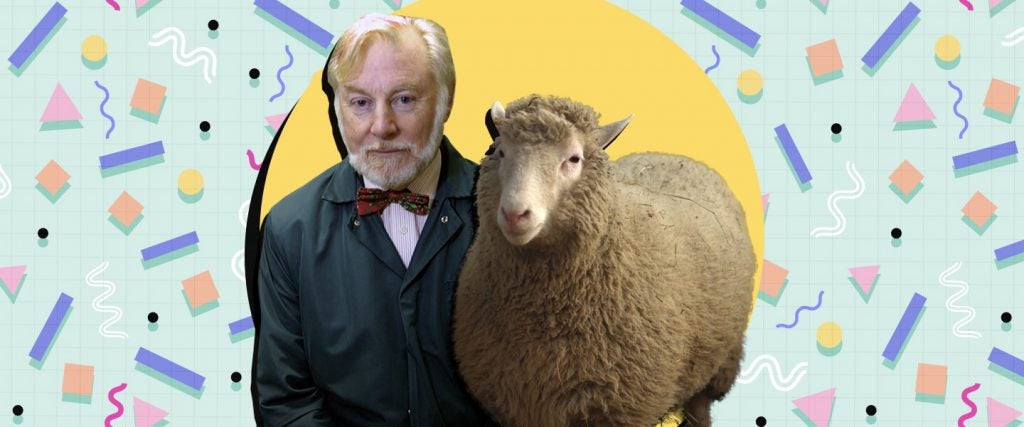2022 marks the 25th anniversary of the year that everything happened — 1997. It was an ear-biting, Pierce Brosnan-loving, comet-obsessed world, and we’re here to relive every minute of it. Twice a week over the next 12 months, we will take you back to the winter of sheep cloning and the summer of Con Air. Come for the Chumbawamba, and stay for the return of the Mack. See all of the stories here.
In late February of 1997, the world learned of the existence of Dolly, a Finnish Dorset sheep who had been born the previous summer in Scotland, at the University of Edinburgh’s Roslin Institute. She was the first mammal to be cloned from an adult cell instead of an embryo cell. But to the public, she was simply the first — a breakthrough that would change everything.
It’s funny to imagine the same announcement today. On the one hand, you’d have conspiracists spinning up wild tales of how Dolly came to be, whether she was a true clone and why the Roslin scientists had kept her a secret for the better part of a year. We might’ve also fielded social media outrage as people learned Dolly was named after country legend Dolly Parton because the cell used to clone her came from a mammary gland — which meant that this stunning leap forward in human knowledge would be branded with a boob joke for all of history. Dr. Ian Wilmut, later knighted for his research, remarked at the time that the team “couldn’t think of a more impressive pair of glands than Dolly Parton’s,” as the BBC dryly reported.
Wilmut wasn’t “canceled” by feminists, however, nor was the team that created Dolly targeted by an extreme right-wing movement accusing them of Satanic blood magic. In the late 1990s, establishment media still had some control over the discourse. Weekly magazines and TV news broadcasts touted Dolly as an incredible advance — before this, Jurassic Park had been most people’s education in the principles of cloning — and jumped to a new hypothetical: human clones. “Will There Ever Be Another You?” asked the cover of Time. “Are Humans Next?” wondered ScienceWorld. “If a man, why not a lamb?” mused ABC anchor Peter Jennings.
In retrospect, it’s as if we bypassed the actual landmark to indulge a vision of our species as far more advanced than it really was. Typical end-of-the-millennium progressivism imagined a world in which the only challenges left were biological — war and injustice would die off in the steady march of globalization, leaving us to solve hunger, disease and death itself. That was the spirit of the Dolly conversation: Soon we’ll live forever.
So much was made of the potential for human doppelgängers, and the host of moral and ethical concerns around them, that nations moved to ban such cloning, rather unusual given that the law usually has to catch up to cutting-edge technology, not the other way around: It took another two decades to successfully clone primates, and when a Chinese team in 2018 produced two long-tailed macaques from fetal cells, they reported that attempts to do the same with adult cells had failed. That is, they couldn’t make a monkey identical to a living adult, as Dolly was the double of a six-year-old sheep.
A general misunderstanding of what Dolly represented and unspoken assumptions of our mastery over nature created the sense that the achievement was not just momentous but easy, an inevitable step forward. Rarely was it mentioned that sheep had already been cloned in the 1980s, just not the same way, nor was it often remarked that Dolly had emerged from a field of 277 nuclei, only 29 of which became implanted embryos, she the single one to survive till birth. The cloning had been difficult, expensive and inefficient, and so far, the experiment has had greater implications for livestock breeding and stem-cell medicine than human reproduction.
Nevertheless, Dolly is cited today by those who believe governments have cloned people in secret ever since. Insofar as she represents a shift in the cultural consciousness — it is possible to copy a living organism — she even set the stage for hoax claims that Joe Biden is a clone.
Dolly’s death in 2003 was likewise misinterpreted: Because she had to be euthanized at a relatively young age, and analysis had shown she had unusually short telomeres (the sequences of DNA at the end of chromosomes, which shorten with age), it was thought that clones would always suffer health problems and abbreviated lives. Further study has challenged that conclusion, but, as with Dolly’s birth, no one could prevent the less accurate interpretations from taking root. It’s a constant problem for science journalism: how to convey the nuance and ongoing process of discovery while imparting new revelations in accessible language.
Yet for all the exaggerated optimism, oversimplification and premature philosophizing that greeted Dolly — the starry-eyed agreement that we were on the precipice of a fundamentally new era — there remains something quaint in the media frenzy she created, and the very big questions she prompted. Has any laboratory event in the 25 years since occasioned such awe? The most significant in recent memory, the development of effective COVID-19 vaccines amid the pandemic, has instead entrenched a demographic of science deniers. But then, the biochemists working on that didn’t have a cute and humble animal mascot, this unlikely celebrity creature with no idea of her importance. She heralded a future that didn’t arrive; she was a miracle anyway. And until one of us is cloned, she’ll be the symbol of that promise.

